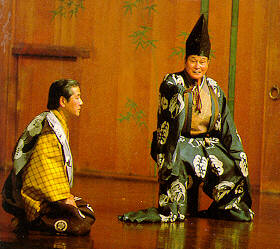
Kyogen

This is another form of Japanese theater but not exactly as serious as the other forms. There is no exact origin point of kyogen theater, but it probably goes back to some form of religious worship.
Its development seems related to the development of several other things. One of these is the court jester. Another was the sangaku, which is rhythmic beating of drums and other instruments combined with a type of dancing. This gradually changed into sarugaku, or "monkey music", which combined the court jester's activities with acrobatics, juggling, tumbling, singing and recitation.
By the middle of the 11th century one form of this altered into a form of social comedy. At the same time, dengaku developed in the agricultural community, which consisted of ten or more performers with drums, drum-sticks and flutes, singing rural songs and dancing.
Gradually, both dengaku and sarugaku became linked to various national shrines, with sarugaku gradually becoming more of a stage-play type thing by the 14th century.
One of the main founders of Noh, Kwanami, named the comic element of plays kyogen, or "mad words." His son, Zeami, refined the concept by noting that the comedy should not be of a vulgar nature, and should be subtle in character.
The first essay totally about kyogen was by Toraaki Yaemon Okura in 1660.He stated that a
Priest Gene (1269-1350) was the first author of the comedies, and named 59 specific plays.
Kyogen consists of 257 independent one-act comic plays. It deals mainly with daily existence rather than great historical and mythological themes.
There will be two or three people with no sets or special lighting. Few props are used, either, so basically it's up to the actors to use skill to make the performance believable and entertaining.
The plays are often satires on social evils and human behavior. The dialogue in the plays consists of colloquialisms of the Muromachi period. A lot of emphasis in the play is on the gestures of the performers. Popular superstitions are also important in the plays.
The costumes are nice but much less elaborate than those in Noh, for example. They basically are used to indicate the social position of the particular character. Since the people in the plays are common people, simple, rustic garments are the ones used.
One type is the suo. This is a short jacket with long sleeves. There is also the kataginu, which lacks sleeves. They are made of hemp rather than silk. The designs used are kept simple. The oldest kyogen robe that exists is from the 16th century. Since there are very few old costumes, most of our knowledge comes from paintings and literary descriptions of the times.
Among other things, the designs could include flowers (dandelions and grape blossoms for spring; hydrangeas for summer; chrysanthemums and bush clover for autumn and evergreen pines and bamboo for winter); grasses, birds, animals and insects. Vegetables like radishes could be used and even praying mantises found their way onto some costumes.
Kyogen masks are simpler than Noh masks and are less numerous in their variety. They include ordinary citizens, smiling gods of good fortune, ghosts, animals and demons.

Main Index
Japan main page
Japanese-American Internment Camps index page
Japan and World War II index page
|